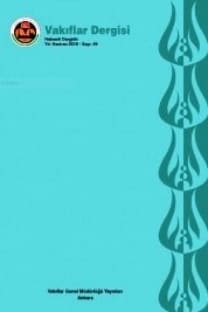Hz. Yusuf ve Bijen Minyatürlerine kuyu metaforu' açısından bir bakış
İslam minyatürleri içerisinde Hz. Yusuf ile ilgili minyatürlerin oldukça geniş yer tuttuğu görülmektedir. Bu minyatürlere Yûsuf u Züleyhâ, Heft Evreng, Kısasül Enbiyâ, Gülistan, Bostan, Mecmaüt-Tevârih, Hadikatüs-Süedâ gibi elyazması eserlerin nüshalarında sıklıkla rastlanmaktadır. Söz konusu minyatürlerin konu yelpazesindeki çeşitlilik dikkati çekmektedir. Öyle ki Hz. Yusufun ahsenükasas adı verilen hayat hikâyesinin en çarpıcı kesitleri adeta tüm ayrıntılarıyla minyatürlerde tasvir edilmiştir. Hz. Yusuf kıssasının en ibretlik bölümlerinden olan Hz. Yusufun kardeşleri tarafından kuyuya atılması hadisesi ise genel olarak minyatürler içerisinde en az yer verilen konulardan biridir. Esasen Hz. Yusufun hayatının en özgün taraflarından birini teşkil eden kuyuda geçirilen zaman dilimi nedense diğer hadiseler kadar minyatürlerde işlenmemiştir. Az sayıdaki bu minyatürler kuyu metaforu açısından değerlendirildiğinde ayrı bir önem arz etmektedir. Bu çalışmada Hz. Yusuf minyatürleri kuyu metaforu bağlamında Firdevsînin Şehnâme isimli eserinin kahramanlarından biri olan Bijenin hayatındaki kuyuya atılma hadisesiyle de mukayese edilerek incelenecektir.
A view on miniatures of prophet Joseph and bizhan in terms of well metaphor
It is clear that miniatures about Prophet Joseph loom large in Islamic miniatures. It has frequently been coincided with these miniatures in copies of some manuscripts like Yusuf and Zulaikha (Joseph and Potiphar s wife), Haft Awrang, Qisas al-Anbiya, Gulistan, Bustan, Majma al-Tavarikh, Hadiqat al-Suada. Diversity in subjects of the foregoing miniatures attracts attention. The most striking sections of Akhsan al-Qasas called life story of Prophet Joseph have been illustrated in the miniatures with almost all details. The event To get thrown out Joseph to the well by his brothers which is one of the most exemplary sections of Prophet Joseph s life story is usually the least illustrated subject in the miniatures. Actually, time period in the well which is the most original part of Prophet Joseph s life story somehow has not been processed in the miniatures as much as other events. When these limited number of miniatures are assessed in terms of well metaphor, they are exceptionally important. In this study, the miniatures of Prophet Joseph are analysed with context of well metaphor comparing with Bizhan, who is one of heroes in Shahnameh of Firdawsi.
___
- AND, M. (2002). Osmanlı Tasvir Sanatları: 1 Minyatür, İstanbul: Türkiye İş Bankası Yayınları.
- AND, M. (2010). Minyatürlerle Osmanlı-İslam Mitologyası, İstanbul: Yapı Kredi Yayınları.
- BARRY, M. (2004). Figurative Art in Medieval Islam and the Riddle of Bihzad of Herat (1465-1535), Flammarion.
- BROSH, N., MILSTEIN, R. (1991). Biblical Stories in Islamic Painting, Jerusalem: The Israel Museum.
- ÇAĞMAN, F., TANINDI, Z. (1979). Topkapı Sarayı Müzesi İslam Minyatürleri, İstanbul: Tercüman Sanat ve Kültür Yayınları.
- DIMAND, M. S. (1929). Dated Specimens of Mohammedan Art in the Metropolitan Museum of Art: Part II, Metropolitan Museum Studies, vol. 1. (http://www.jstor.org/stable/1522725)
- EFLAKİ, A. (2006). Ariflerin Menkıbeleri, İstanbul: Kabalcı Yayınevi.
- FARHAD, M., BAĞCI, S. (2009). Falnama The Book of Omens, USA: Thames&Hudson.
- FİRDEVSÎ. (2009). Şehnâme, İstanbul: Kabalcı Yayınevi.
- FUZULİ. (1987). Hadikatüs-Süedâ, haz. Şeyma Güngör, Ankara: Kültür ve Turizm Bakanlığı Yayınları.
- GALİP, Ş. (2006). Hüsn ü Aşk, İstanbul: Dergâh Yayınları.
- GUEST, G. D. (1943). Notes on the Miniatures on a Thirteenth-Century Beaker, Ars Islamica, vol. 10.(http://www. jstor.org/stable/4515619)
- HOLBROOK, V. R. (2012). Aşkın Okunmaz Kıyıları, çev. Erol Köroğlu, Engin Kılıç, İstanbul: İletişim Yayınları.
- İPEKTEN, H. (1991). Fuzûlî Hayatı Sanatı Eserleri, Ankara: Akçağ Yayınları.
- KANAR, M. (1996). Firdevsî, Diyanet İslam Ansiklopedisi, c. 13, İstanbul.
- KURTULUŞ, R. (1998). Heft Evreng, Diyanet İslam Ansiklopedisi, c. 17, İstanbul.
- MEREDITH-OWENS, G. M. (1969). Turkish Miniatures, London: The Trustees of the British Musuem.
- MEREDITH-OWENS, G. M. (1970). Some Remarks on the Miniatures in the Societys Jami Al-Tawarikh, Journal of the Royal Asiatic Society of Great Britain and Ireland.
- (http://www.jstor.org/stable/25203211)
- MERGUERIAN, G. K., NAJMABADI, Afsaneh. (1997). Zulaykha and Yusuf: Whose Best Story?, International Journal of Middle East Studies, vol. 29. (http://www.jstor.org/stable/164399)
- MEVLÂNÂ. (2007). Sırların Dili, çev. Ziya Avşar, Konya: Meram Belediyesi Kültür Yayınları.
- MEVLÂNÂ. (2010). Mesnevî-i Şerîf, çev. Süleyman Nahîfî, İstanbul: Timaş Yayınları.
- MILSTEIN, R. (1990). Miniature Painting in Ottoman Baghdad, U.S.A.: Mazda Publishers.
- ROBINSON, B. W. (1980). Rashid al-Dins World History: The Significance of the Miniatures, Journal of the Royal Asiatic Society of Great Britain and Ireland.
- (http://www.jstor.org/stable/25211170)
- ROXBURGH, D. (2000). Kamal al-Din Bihzad an Authorship in Persianate Painting, Muqarnas, vol. 17. (http://www. jstor.org/stable/1523294)
- RÜHRDANZ, K. (1997). About a Group of Truncated Shahnamas: A Case Study in the Commercial Production of Illustrated Manuscripts in the Second Part of the Sixteenth Century, Muqarnas, vol. 14. (http://www.jstor.org/stable/1523240)
- SIMPSON, M. S. (1982). The Production and Patronage of the Haft Aurang byJami in the the Freer Gallery of Art, Ars Orientalis, vol. 13. (http://www.jstor.org/stable/4629313)
- SOUDAVAR, A. (2000). The Age of Muhammadi, Muqarnas, vol. 17. (http://www.jstor.org/stable/1523290)
- SWIETOCHOWSKI, M. (1974). The Development of Traditions of Book Illustration in Pre-Safavid Iran, Iranian Studies, vol. 7. (http://www.jstor.org/stable/4310154)
- ŞANLI, İ. (2010). Molla Câmînin Yûsuf u Züleyhâsının Bilinmeyen İki Türkçe Şerhi, Turkish Studies, c. 5/1. http://www.turkishstudies.net/Makaleler/999564323_60%C5%9Fanl%C4%B1ismet.pdf (13.06.2014)
- ULUÇ, L. (2000). Selling to the Court: Late-Sixteenth-Century Manuscript Production in Shiraz, Muqarnas, vol. 17.
- (http://www.jstor.org/stable/1523291)
- UZUN, M. (1995). Falnâme, Diyanet İslam Ansiklopedisi, c. 12, İstanbul.
- YAZIR, H. Hak Dini Kuran Dili, İstanbul: Feza Gazetecilik A. Ş., c. 5.
- YİĞİT, İ. (2010). Peygamberler Tarihi, İstanbul: Kayıhan Yayınları.
- http://www.wdl.org/en/item/7494/view/1/118/ (13.06.2014).
- http://stabikat.de/CHARSET=ISO-8859-1/DB=1/LNG=DU/CMD?ACT=SRCHA&IKT=1016&SRT=YOP&TRM=qisas+al-an- biya+nishapuri (13.06.2014).
- ISSN: 1011-7474
- Başlangıç: 2015
- Yayıncı: Mehmet Kurtoğlu
Sayıdaki Diğer Makaleler
II. meşrutiyet devrinde Osmanlı medreselerinde reform çabaları ve merkezileşme
16. yüzyılda halep'te bir Osmanlı vakfı: Hüsreviye külliyesi
XV ve XVI. yüzyıllarda Doğu Karadeniz'de yol hizmeti veren zaviyeler ve derbendler
Hz. Yusuf ve Bijen Minyatürlerine kuyu metaforu' açısından bir bakış
XIV. yüzyıl Akşehir’inde Bir Sûfî: Hacı İbrahim Sultan ve Manzûmesi
AB Türkiye ilerleme raporlarında mazbut kavramı sorunu
İstanbul halı müzesi -geçmişten bugüne halı ile tarihibir yolculuk-
Havsa'daki Şehit Mehmed Paşazade KasımPaşa vakfı
Afganistan-belh bahaüddin velet medresesi restorasyon kazı ve çalışmaları
